
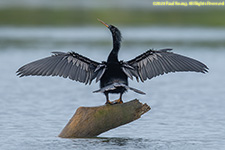 Anhinga (male), Anhinga anhinga leucogaster
Anhinga (male), Anhinga anhinga leucogasterOne of the most fruitful areas for wildlife photography was the Snyder (Changuinola) Canal, originally built in 1898 to transport banana barges for what is now Chiquita. The canal connects the mouth of the Changuinola River to Almirante Bay about 5km east of Changuinola and is now an important wetland reserve, Humedal de San San Pond Sak. We also visited the Green Acres Cacao Plantation on the mainland, which produces organically-grown Criollo chocholate and is a good location to find poison dart frogs as well as birds. We also crossed to the mainland and drove to the Continental Divide from Chiriqui Grande and birded our way back down the Western Caribbean slope.
Anhingas are closely related to cormorants. They swim with only the head and neck visible above the water.

 Anhinga (male), Anhinga anhinga leucogaster
Anhinga (male), Anhinga anhinga leucogaster
Anis and cuckoos are mainly insectiverous, slender, and have long tails. Anis are communal breeders, laying their eggs together in a large bulky nest and sharing in raising the young.
 Mangrove cuckoo, Coccyzus minor
Mangrove cuckoo, Coccyzus minor
 Squirrel cuckoo, Piaya cayana thermophila
Squirrel cuckoo, Piaya cayana thermophila
 Striped cuckoo, Tapera naevia excellens
Striped cuckoo, Tapera naevia excellens
 Groove-billed ani, Crotophaga sulcirostris
Groove-billed ani, Crotophaga sulcirostris
Antshrikes and Antwrens do not actually eat ants, but snap up any prey disturbed by army ants.

 Black-crowned antshrike, Thamnophilus atrinucha
Black-crowned antshrike, Thamnophilus atrinucha
 Russet antshrike, Thamnistes anabatinus
Russet antshrike, Thamnistes anabatinus
 Dot-winged antwren, Microrhopias quixensis
Dot-winged antwren, Microrhopias quixensis
Becards are found in lower to middle levels of woodland, forest edge, and clearings with trees.

 White-winged becard, Pacyramphus polychopterus similis
White-winged becard, Pacyramphus polychopterus similis
Bellbirds are cotingas. Males have three black, drooping, wormlike wattles from their bills.
 Three-wattled bellbird (female), Procnias tricarunculatus
Three-wattled bellbird (female), Procnias tricarunculatus
Caracaras are New World falcons. They often feed among cattle, eating the larvae of social insects, or on roadkill carrion.


 Yellow-headed caracara (adults left, juvenile right), Daptrius chimachima cordata
Yellow-headed caracara (adults left, juvenile right), Daptrius chimachima cordata
Chachalacas resemble pheasants and turkeys.
 Gray-headed chachalaca, Ortalis cinereiceps
Gray-headed chachalaca, Ortalis cinereiceps
Cormorants have long necks and long square tails. They are found worldwide in both freshwater and marine environments.
 Neotropic cormorant, Nannopterum brasilianum brasilianum
Neotropic cormorant, Nannopterum brasilianum brasilianum
Cotingas eat fruits and are restricted to the Neotropics.
 Snowy cotinga, Carpodectes nitidus
Snowy cotinga, Carpodectes nitidus
Ducks and coots: Ducks have broad, flattened bills and live mainly in fresh-water environments. Only the resident black-bellied whistling duck and the migrant blue-winged teal are common and widespread. Coots are members of the rail family.

 Black-bellied whistling-duck, Dendrocygna autumnalis
Black-bellied whistling-duck, Dendrocygna autumnalis

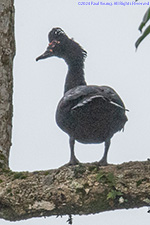 Muscovy duck, Cairina moschata
Muscovy duck, Cairina moschata

 Blue-winged teal (male left, females right), Spatula discors
Blue-winged teal (male left, females right), Spatula discors


 American wigeon (males left, females right), Mareca americana
American wigeon (males left, females right), Mareca americana
 American coot, Fulica americana americana
American coot, Fulica americana americana
Falcons resemble hawks. They have pointed wings and are swift fliers.
 Laughing falcon, Herpetotheres cachinnans cachinnans, preys on snakes
Laughing falcon, Herpetotheres cachinnans cachinnans, preys on snakes
Flycatchers, kingbirds, and kiskadees: There are nearly 400 species of these New World insect feeders, the largest family of birds in the New World.

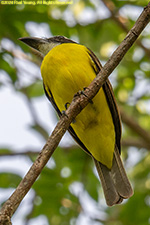 Boat-billed flycatcher, Megarynchus pitangua mexicanus
Boat-billed flycatcher, Megarynchus pitangua mexicanus

 Great kiskadee, Pitangus sulphuratus guatimalrnsis
Great kiskadee, Pitangus sulphuratus guatimalrnsis

 Tropical kingbird, Tyrannus melancholicus satrapa
Tropical kingbird, Tyrannus melancholicus satrapa
Frigatebirds harass other flying birds into dropping their catch, which they then scoop up in flight. Male birds have an inflatable throat pouch used in courtship display.
 Magnificent frigatebird, Fregata magnificens
Magnificent frigatebird, Fregata magnificens
Grackles occur only in the Americas. They have long, conical, pointed bills and very long tails.
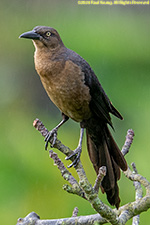 Great-tailed grackle (female), Quiscalus mexicanus peruvianus
Great-tailed grackle (female), Quiscalus mexicanus peruvianus
Gulls have a heavier build and stouter bill than terns and are often seen swimming.


 Laughing gull (first winter right), Leucophaeus atricilla
Laughing gull (first winter right), Leucophaeus atricilla
Hawks are diurnal birds of prey. Common black hawks are nearly always seen near water and feed mostly on crabs.

 Common black hawk (adult left, juvenile right), Buteogallus anthracinus anthracinus
Common black hawk (adult left, juvenile right), Buteogallus anthracinus anthracinus
 Broad-winged hawk, Buteo platypterus platypterus
Broad-winged hawk, Buteo platypterus platypterus
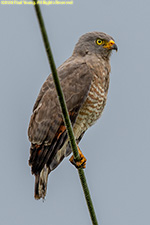
 Roadside hawk, Rupornis magnirostris petulans
Roadside hawk, Rupornis magnirostris petulans
Herons, egrets, and limpkins: Herons and egrets, long-necked, long-legged wading birds, are found worldwide. The ibis-like limpkin is in its own family, related to cranes and rails.
 Great egret, Ardea alba egretta
Great egret, Ardea alba egretta

 Little blue heron (adult left, juvenile right), Egretta caerulea
Little blue heron (adult left, juvenile right), Egretta caerulea


 Snowy egret, Egretta thula thula
Snowy egret, Egretta thula thula

 Great blue heron, Ardea herodias
Great blue heron, Ardea herodias
 Tricolored heron, Egretta tricolor ruficollis
Tricolored heron, Egretta tricolor ruficollis
 Green heron, Butorides virescens virescens
Green heron, Butorides virescens virescens
 Yellow-crowned night-heron, Nyctonassa violacea caliginis
Yellow-crowned night-heron, Nyctonassa violacea caliginis
 Limpkin, Aramus guarauna dolosus
Limpkin, Aramus guarauna dolosus
Honeycreepers are tanagers.


 Green honecreeper (males left, female right), Chlorophanes spiza argutus
Green honecreeper (males left, female right), Chlorophanes spiza argutus
Hummingbirds, the world's smallest birds, are found only in the Americas, mostly in the tropics. They are important pollinators in tropical forests, especially of red, orange, and yellow flowers. Hermits feed in the lower forest layers.
 Stripe-throated hermit, Phaethornis striigularis saturatus
Stripe-throated hermit, Phaethornis striigularis saturatus



 Purple-crowned fairy, Heliothryx barroti
Purple-crowned fairy, Heliothryx barroti

 Rufous-tailed hummingbird, Amazilia tzacati tzacati
Rufous-tailed hummingbird, Amazilia tzacati tzacati
 Blue-chested hummingbird (male), Polyerata amabilis
Blue-chested hummingbird (male), Polyerata amabilis
 White-throated emerald, Micochera chionura
White-throated emerald, Micochera chionura

 Stripe-tailed hummingbird, Eupherusa eximia egregia
Stripe-tailed hummingbird, Eupherusa eximia egregia
 White-necked Jacobin (male), Florisuga mellivora mellivora
White-necked Jacobin (male), Florisuga mellivora mellivora

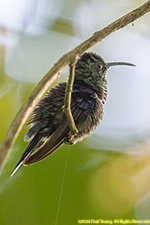 Crowned (violet-crowned) woodnymph, Thalurania colombica venusata
Crowned (violet-crowned) woodnymph, Thalurania colombica venusata
Ibises occur worldwide but are most common in the tropics. They are heron-like waders with distinctive decurved bills. Unlike herons, ibises fly with their necks outstretched.
 Green ibis, Mesembrinibis cayennensis
Green ibis, Mesembrinibis cayennensis
Jacanas and gallinules: Jacanas have extraordinarily long toes that allow them to walk on floating vegetation. Gallinules are members of the rail family, related to coots.
 Northern jacana, Jacana spinosa spinosa
Northern jacana, Jacana spinosa spinosa
 Common gallinule, Gallinule galeata cachinnans
Common gallinule, Gallinule galeata cachinnans
Jays are omnivrous and occur nearly worldwide. Four species are found in Panama.
 Brown jay, Psilorhinus morio cyanogenys
Brown jay, Psilorhinus morio cyanogenys
Kingfishers nest in burrows excavated in steep banks. All six species found in the Americas occur in Panama.


 Amazon kingfisher (females left, male right), Chloroceryle amazona
Amazon kingfisher (females left, male right), Chloroceryle amazona
 Green kingfisher (female), Chloroceryle americana septentrionalis
Green kingfisher (female), Chloroceryle americana septentrionalis
 American pygmy kingfisher, Chloroceryle aenea aenea
American pygmy kingfisher, Chloroceryle aenea aenea

 Belted kingfisher (female), Megaceryle alcyon
Belted kingfisher (female), Megaceryle alcyon
Kites are diurnal birds of prey with hooked beaks. Snail kites pluck snails from aquatic cagatation and take them to a perch to eat, extracting them with its hooked bill.


 Double-toothed kite (juvenile), Harpagus bidentatus fasciatus
Double-toothed kite (juvenile), Harpagus bidentatus fasciatus

 Snail kite, Rostrhamus sociabilis
Snail kite, Rostrhamus sociabilis
Lapwings resemble sandpipers but are stockier and have shorter, thicker bills and larger eyes.
 Southern lapwing, Vanellus chilensis cayennensis
Southern lapwing, Vanellus chilensis cayennensis
Manakins are small chunky fruit-eating birds with large heads, big eyes, and a short tail and bill. They are found exclusively in the Neotropics.

 Golden-collared manakin (male), Manacus vitellinus vitellinus
Golden-collared manakin (male), Manacus vitellinus vitellinus
 Red-capped manakin (male), Ceratopipra mentalis
Red-capped manakin (male), Ceratopipra mentalis
Martins and Swallows are among the most aerial of birds, feeding mostly on insects caught on the wing.
 Gray-breasted martin, Progne chalybea chalybea
Gray-breasted martin, Progne chalybea chalybea

 Mangrove swallow, Tachycineta albilinea
Mangrove swallow, Tachycineta albilinea
Meadowlarks occur only in the Americas. They have long, conical, pointed bills.

 Red-breasted meadowlark (blackbird) (male left, female right), Leistes (Sturnella) militaris
Red-breasted meadowlark (blackbird) (male left, female right), Leistes (Sturnella) militaris
Mockingbirds comprise a small family found only in the Americas.
 Tropical mockingbird, Mimus gilvus
Tropical mockingbird, Mimus gilvus
Nighthawks are nocturnal aerial hunters of flying insects. They are related to swifts and have weak feet and long slender wings.
 Short-tailed nighthawk, Lurocolis semitorquatus noctivagus
Short-tailed nighthawk, Lurocolis semitorquatus noctivagus
Orioles are found only in the Americas.
 Baltimore oriole, Icterus galbula
Baltimore oriole, Icterus galbula
Oropendolas: The Montezuma oropendola is the largesr and most colorful of Central American oropendolas.

 Montezuma oropendola, Psarocolius montezuma
Montezuma oropendola, Psarocolius montezuma
Parrots: Nearly half of the world's 332 parrot species live exclusively in the Neotropics. 22 species occur in Panama. Many are predominantly green with patches of red, yellow, or blue. They usually nest in tree hollows. Parrots use their strong stout bills to feed on fruits and nuts, often holding and manipulating food with their feet.
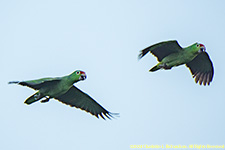



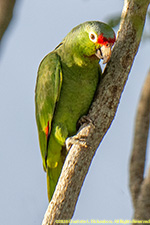 Red-lored parrot, Amazona autumnalis salvini
Red-lored parrot, Amazona autumnalis salvini
 Blue-headed parrot, Pionus menstruus rubrigularis
Blue-headed parrot, Pionus menstruus rubrigularis

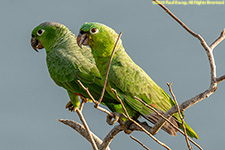 Mealy parrot, Amazona farinosa virenticeps
Mealy parrot, Amazona farinosa virenticeps
 Olive-throated parakeet, Eupsittula nana astec
Olive-throated parakeet, Eupsittula nana astec
Pigeons and doves: Most Neotropical ptgeons and doves are rather drab and well-camouflaged, with bulky bodies, small heads, thin soft bills, and short legs.




 Pale-vented pigeon, Patagionas cayennensis pallidicrissa
Pale-vented pigeon, Patagionas cayennensis pallidicrissa
 Ruddy ground dove, Columbina talpacoti rufipennis
Ruddy ground dove, Columbina talpacoti rufipennis
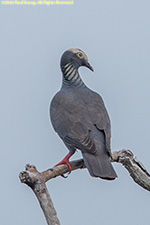

 White-crowned pigeon (adults left, immature right), Patagioenas leucocephala
White-crowned pigeon (adults left, immature right), Patagioenas leucocephala
 Short-billed pigeon, Patagioenas nigrirostris
Short-billed pigeon, Patagioenas nigrirostris
Plovers resemble sandpipers but are generally stockier and have shorter, thicker bills and larger eyes.
 Collared plover, Anarhynchus (Charadrius) collaris
Collared plover, Anarhynchus (Charadrius) collaris
Puffbirds can fluff out their feathers to give them a ball-like appearance, Eight species are found in Central America.
 Pied puffbird, Notharchus tectus subtectus
Pied puffbird, Notharchus tectus subtectus
Sandpipers, stilts, and dowitchers: All sandpipers and dowitchers found in Panama are migrants that breed further north. Stilts are long-legged shorebirds with long straight bills.
 Black-necked stilt, Himantopus mexicanus mexicanus
Black-necked stilt, Himantopus mexicanus mexicanus
 Short-billed dowitcher, Limnodromus griseus
Short-billed dowitcher, Limnodromus griseus
 Solitary sandpiper, Tringa solitaris
Solitary sandpiper, Tringa solitaris
Saltators are heavy-billed, mostly dull-colored birds related to tanagers.
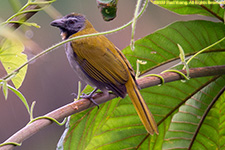 Buff-throated saltator, Saltator maximus
Buff-throated saltator, Saltator maximus
 Cinnamon-bellied saltator, Saltator grandis
Cinnamon-bellied saltator, Saltator grandis
Seed-finches have large heavy bills.
 Thick-billed seed-finch, Sporophila funerea
Thick-billed seed-finch, Sporophila funerea
Seedeaters have stout bills design for cracking seeds.
 Variable seedeater, Sporophila corvina corvina
Variable seedeater, Sporophila corvina corvina
Skimmers have odd, laterally compressed bills with the lower mandible longer than the upper. They catch fish by flying low above the water and plowing its surface with the lower mandible.
 Black skimmer, Rynchops niger niger
Black skimmer, Rynchops niger niger
Tanagers and dacnis are a large family unique to the New World. Typical tanagers are 5-6" long, have stout bills, and most eat fruit.
 Tawny-crested tanager (male), Tachyphonus delatrii
Tawny-crested tanager (male), Tachyphonus delatrii

 Plain-colored tanager, Tangara inornata
Plain-colored tanager, Tangara inornata
 Scarlet-rumped tanager, Ramphocelus passreinii passerinii
Scarlet-rumped tanager, Ramphocelus passreinii passerinii
 White-shouldered tanager (male), Loriotus (Tachyphorus) luctuosus axillaris
White-shouldered tanager (male), Loriotus (Tachyphorus) luctuosus axillaris



 Palm tanager, Thraupis palmarum atripennis
Palm tanager, Thraupis palmarum atripennis

 Blue-gray tanager, Thraupis episcopus cana
Blue-gray tanager, Thraupis episcopus cana
 Scarlet tanager (nonbreeding male), Piranga olivacea
Scarlet tanager (nonbreeding male), Piranga olivacea

 Blue dacnis (male left, female right), Dacnis cayana
Blue dacnis (male left, female right), Dacnis cayana
Terns: the royal tern is a very common winter resident.
 Royal tern, Thalasseus maximus maximus
Royal tern, Thalasseus maximus maximus
Tityras are found in the middle and upper levels of forest and woodland and in nearby clearings with trees.

 Masked tityra (male), Tityra semifasciata costaricensis
Masked tityra (male), Tityra semifasciata costaricensis
 Black-crowned tityra, Tityra inquisitor fraserii
Black-crowned tityra, Tityra inquisitor fraserii
Toucans and aricaris often perch in the open. There are seven Central American species. They are the dominant avian frugivore in Neotropical forests. Their flight is an undulating flap-and-glide. Toucans are related to barbets.

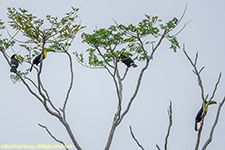
 Keel-billed toucan, Ramphastos sulfuratus brevicarinatus
Keel-billed toucan, Ramphastos sulfuratus brevicarinatus



 Collared aricari, Pteroglossus torquatus torquatus
Collared aricari, Pteroglossus torquatus torquatus
 Yellow-throated (chestnut-mandibled) toucan, Ramphastos ambiguus swainsonii
Yellow-throated (chestnut-mandibled) toucan, Ramphastos ambiguus swainsonii
Trogons are sit-and-wait predators of insects. They are medium-sized, with strong, broad bills, a wide gape, a squared-off tail, strong feet, and broad, rounded, naneuverable wings.
 Slaty-tailed trogon, Trogon massena hoffmanni
Slaty-tailed trogon, Trogon massena hoffmanni
The turkey vulture is the second-most common species of New World vulture in Central America, feeding mostly on carrion. Black vultures are scavengers. New World vultures resemble Old World vultures but are not closely related.

 Turkey vulture (tropical), Cathartes aura ruficolis
Turkey vulture (tropical), Cathartes aura ruficolis
 Black vulture, Coragyps atratus brasiliensis
Black vulture, Coragyps atratus brasiliensis
Warblers (wood-warblers) are a large family of mainly insectiverous birds occurring exclusively in the Americas.








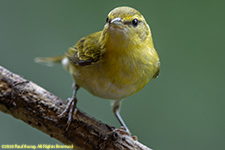 Tennessee warbler, Leiothlypis peregrina
Tennessee warbler, Leiothlypis peregrina

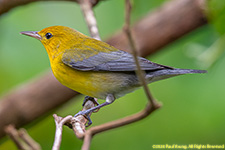 Prothonotary warbler (male left, female right), Protonotaria citrea
Prothonotary warbler (male left, female right), Protonotaria citrea
Woodpeckers have strong, straight, chisel-like bills, grasping feet, and stiffened tail feathers that serve as props. They feed mainly on wood'boring insects.

 Black-cheeked woodpecker, Melanerpes pucherani
Black-cheeked woodpecker, Melanerpes pucherani
Xenops are acrobatic woodcreepers found at middle and upper levels of forests, often hanging upside down.
©2024 Mermaid Underwater Photographic. All Rights Reserved.
Contact us at mermaid@underwater.org.
Last modified 26 March 2024